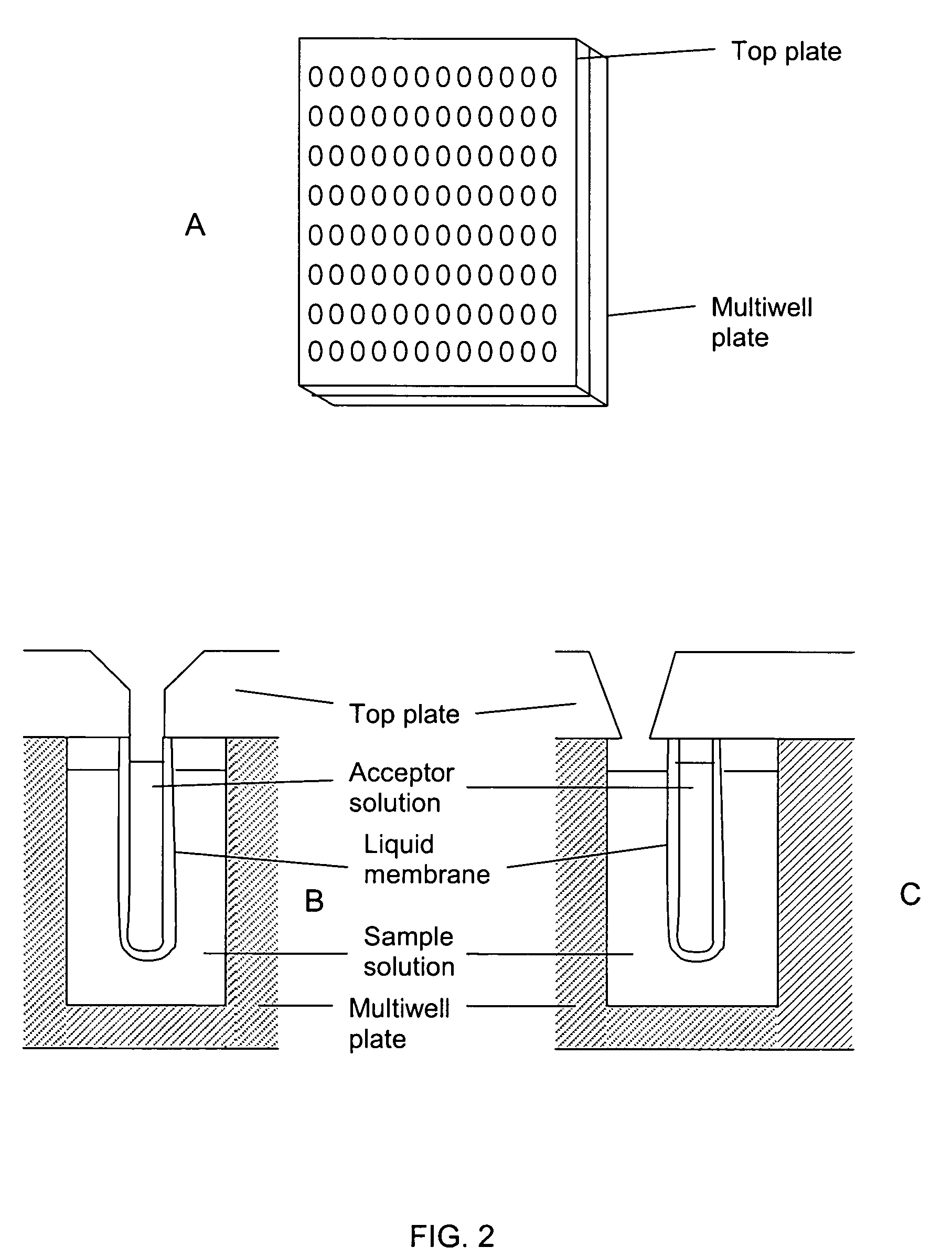Stable liquid membranes for liquid phase microextraction
a liquid phase microextraction and stable technology, applied in the field of sample preparation techniques, can solve the problems of insufficient concentration of analytes, inability to detect complex samples, interference or damage of sensitive instruments, etc., and achieve the effect of stable extraction performan
- Summary
- Abstract
- Description
- Claims
- Application Information
AI Technical Summary
Problems solved by technology
Method used
Image
Examples
example 1
Stability of Liquid Membranes Immobilized on Hollow Fibers
[0086] Initial experiments were performed using n-octanol or dihexyl ether as the organic solvent immobilized in the pores of hollow fibers constructed from polypropylene. These solvents were selected based on their low polarity, hydrophobic capillary attraction forces to the pores of the hollow fibers, low volatility, intermediate solubility for analytes, and low viscosity resulting in acceptable analyte permeability. Liquid membranes comprising n-octanol or dihexyl ether were prepared using the following procedure:
[0087] The liquid membrane was formed by dipping the hollow fiber into the organic solvent for 5 to 30 sec to allow the solvent to penetrate into the pores of the fiber. Then acceptor solution was introduced into the lumen of the fiber using a syringe. The acceptor solution was 10 mM HCl, having a pH of 2. Extraction ability was tested by immersing the hollow fibers with their supported liquid membranes into a s...
example 2
Stability of Fatty Oil Liquid Membranes Immobilized on Hollow Fibers
[0089] Experiments were performed using polypropylene and polysulfone hollow fibers, testing the effectiveness and stability of liquid membranes comprising fatty oils in the extraction of analytes from samples after storage of the fibers for 30 days prior to use. Supported liquid membranes were established on the hollow fibers using the procedures described in Example 1 above, but substituting the following oils for the organic solvents tested in Example 1: tributyrin, soya oil, or olive oil. When fibers were to be stored, they were stored at room temperature attached to syringe needles mounted in a screw cap and placed in 4 mL vials. The fibers were therefore mechanically protected, but air was able to penetrate into the system through the needles and the system was not completely closed. The fibers were stored for 30 days in this manner, and tested as described above.
[0090] The supported liquid membranes of trib...
example 3
Stability of Liquid Membranes Immobilized on Hollow Fibers
[0092] A new study was initiated to prepare and test liquid membranes formed on porous hollow fibers of polypropylene from additional solvent candidates that were ideally chemical substances of high inertness or alternatively a mixture of components with high chemical stability. Liquid membranes composed of dodecyl acetate (DDA), nitropheyloctyl ether (NPOE), and silicone oil AR 20 (AR 20) were tested both alone and in combination. The fibers were stored under the same conditions as described in Example 2. Extraction of 5 different drugs was performed as described in Example 1 using the fibers that had been stored for 30 days. With DDA and NPOE, some of the sample solutions became unclear during the extraction, which indicated that the organic phase was partially removed from the fiber to the sample solution. However, with AR 20, this problem was not observed. The recovery of the 5 different drugs was measured for each of th...
PUM
| Property | Measurement | Unit |
|---|---|---|
| volume | aaaaa | aaaaa |
| concentration | aaaaa | aaaaa |
| concentration | aaaaa | aaaaa |
Abstract
Description
Claims
Application Information
 Login to View More
Login to View More - R&D
- Intellectual Property
- Life Sciences
- Materials
- Tech Scout
- Unparalleled Data Quality
- Higher Quality Content
- 60% Fewer Hallucinations
Browse by: Latest US Patents, China's latest patents, Technical Efficacy Thesaurus, Application Domain, Technology Topic, Popular Technical Reports.
© 2025 PatSnap. All rights reserved.Legal|Privacy policy|Modern Slavery Act Transparency Statement|Sitemap|About US| Contact US: help@patsnap.com



